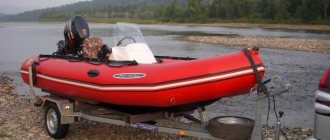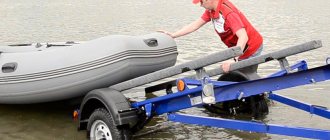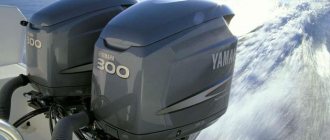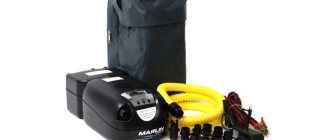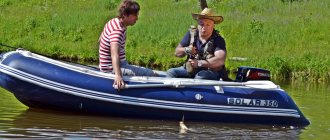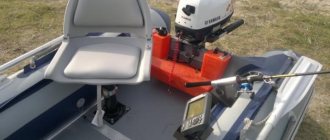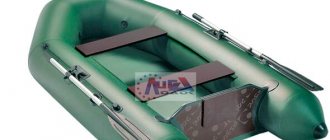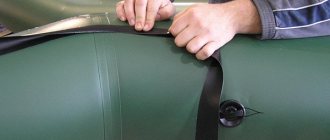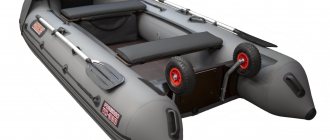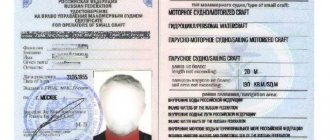The chances of a good catch increase many times over if the fisherman has a boat in his arsenal. If you have vehicles, you can solve the problem of transporting and placing a large watercraft using a special trailer. You can purchase it or make it yourself, here the choice remains free.
Among the finished products there are different models, differing in technical parameters and sizes. This assortment will allow you to find the ideal option for a specific boat or a universal trailer, which can subsequently be used to transport other cargo.
Deciding on the sizes
The parameters of the trailer are determined before the design planning stage. There are strict rules that are provided by law and it is not recommended to violate them.
Before you build a drawing, you need to take measurements from the boat:
- A large assortment will allow you to find the ideal option for a specific boat or a universal trailer, which can subsequently be used to transport other cargo
length;
- side height;
- the length and width of the narrowest and widest sections of the structure.
If the floating craft is large, then the length of the tractor is also measured (from the front bumper to the end of the fastener at the rear).
According to the standards developed at the legislative level, the standard parameters of a trailer for transporting boats are defined:
- structure length – no more than 20 m;
- width – no more than 2.2 m;
- height – no more than 3.8 m.
Moreover, the restrictions apply not only to the trailer, but also to the floating craft itself. This data allows you to navigate highways without causing inconvenience to both the car owner and other road users.
About the characteristics and possibility of manufacturing a trailer for a boat
Sometimes, making a boat trailer with your own hands from existing construction and spare parts is considered the only solution in the current situation. But before you begin such a task, you should study all the characteristics, drawings and technologies.
The completed structure is considered a mobile vehicle, which is subject to the laws and regulations of the State Traffic Safety Inspectorate, traffic rules and must be safe when traveling in conjunction with a tractor-trailer.
When deciding how to make a boat trailer, you should:
- Prepare a project and drawings of boat trailers in accordance with the required overall parameters: height no more than 3.8 m with a boat, width within 2.2 m, length with a tractor up to 20 m;
- Before receiving registration, the trailer must undergo a safety and technical suitability examination by a special certification organization. It is required to coordinate the do-it-yourself boat trailer project and drawings with materials in order to receive a conclusion in the form of a certificate of suitability for use after production;
- After receiving a certificate of suitability, register with the State Traffic Safety Inspectorate and receive a technical certificate and state license. numbers;
- To make a boat trailer, it is recommended to use a certified torsion axle, as well as a factory hitch.
Boats made of the frame type differ from inflatable boats in different characteristics. The latter are small in size and not very expensive, and it is advisable to transport such a boat in a homemade trailer. Such a trailer can be adjusted to fit your existing boat.
When developing, it is necessary to take into account the following parameters:
- The load on the trailer is mostly distributed on the trailer axle and a little on the front. In this position, the trailer will not be lifted up and the load can be safely transported;
- The weight should be centered on the trailer axle to distribute the load evenly on the balls and hubs;
- It is necessary to provide for the installation of removable stops and guides, which will ensure the versatility of using the trailer;
- When installing a trailer, use reliable elements that ensure the safety of the finished structure.
Chassis
There are also rules regarding the chassis, which are supported by state standards. Compliance with them guarantees safe movement on the roads. The axle on which the hinges and wheels are attached must be strong, which is confirmed by tests during trailer registration. Only models intended for motorcycles, mopeds or cars are used as wheels, but not for garden wheelbarrows.
When developing the design of the chassis, it should be taken into account that the load on the front part (location of the tow bar) is 70%, and the remaining 30% is distributed on the rear edge of the frame. This improves the maneuverability of the trailer when traveling on the highway and creates maximum safety for other road users.
The axle on which the hinges and wheels are attached must be strong, which is confirmed by tests during trailer registration
Selection of boat trailer, models and characteristics
Trailer for small boats Model: MZSA 81771C.101-05
Despite its small size, the trailer has good load capacity.
You will be able to transport a boat loaded with the necessary equipment (engine, oars, fishing nets). Anti-corrosion coating protects the metal structure from exposure to adverse environments. The bow is equipped with a manual winch, which will allow you to easily lift the craft out of the water. Characteristics:
- maximum boat length 3.9 m;
- load capacity 560 kg;
- single-axle (two wheels).
Price: 43,100 rubles.
The front chassis is sold separately complete with mounting hardware.
Car light blocks can be easily removed if necessary.
The leaf spring suspension ensures a smooth ride on dirt roads.
Car trailer for small boats and boats
Model: MZSA 81771E.101-05
Undoubtedly one of the most popular models.
The trailer combines a reliable design, the ability to transport optimal weight, and an affordable price. It can accommodate most types of “folk” boats. The trailer is stable, equipped with a manual winch and coated with anti-corrosion powder paint. Characteristics:
- maximum boat length 4.75 m;
- load capacity 540 kg;
- single-axle (two wheels).
Price: 48,000 rubles.
The cradle is adjustable to suit the bottom configuration.
The side lights are assembled into block structures that are easy to remove and put back in place.
The “anatomical” design securely holds the boat.
Trailer for transporting boats and boats
Model: MZSA 821121.202
Biaxial model with increased load capacity.
There are brakes and extendable bars. The cradle and nose pad are adjustable. The coating is durable, anti-corrosion, made using a hot method. Rubber torsion suspension. Characteristics:
- maximum boat length 5.3 meters;
- load capacity 975 kg;
- single-axle (two wheels).
Price 140,000 rubles.
Beauty is in simplicity. Not a single extra detail, not an ounce of excess weight, minimal load on the car.
Lights are mounted on retractable rods and indicate the dimensions of the cargo
The coating of the cradle prevents scratches on the boat hull
Trailer for transporting large boats and mini-yachts
Model: MZSA 822141.602
The model has an anti-corrosion coating and is equipped with a brake system and retractable rods.
The design of the supports protects the keel of the vessel and allows you to securely fix the craft during transportation. The trailer is equipped with a rubber torsion bar suspension; it performed well on smooth asphalt surfaces. Characteristics:
- maximum boat length 7.3 meters;
- load capacity 2550 kg;
- biaxial (four wheels).
Price 223,000 rubles.
Reinforced design designed for heavy boats and small yachts
Metal parts are coated with durable anti-corrosion powder paint
The trailer is equipped with a brake system. If the clutch with the car breaks, your boat will not roll away anywhere.
Trailer for transporting a keel yacht
Model: MZSA 822141.405
Owning a yacht is undoubtedly a luxury that many people dream of. Trailers are made to order for yacht owners. The basic model includes brakes, an unloading mechanism and a winch for loading. The biaxial design is able to withstand a decent weight and deliver the yacht to the water safe and sound.
Characteristics:
- maximum boat length 7 m;
- load capacity 1650 kg;
- biaxial (four wheels).
Price: to order.
Lightweight and reliable design designed for the weight of a small yacht
The designers have provided for everything! Even the keel of the yacht will not be scratched during transportation.
The trailer is made of high-quality rolled metal, each element is a stiffening rib due to its square section.
Boat trailer "Vodnik" (8213 03)
The trailer is specialized.
Designed for transportation of small watercraft (including jet skis). The trailer is equipped with a winch for loading the boat, clamps and supports. The boat is stable during the trip. The low center of gravity prevents the trailer from tipping over. Dump truck function. Characteristics:
- maximum boat length 4.2 meters;
- load capacity 590 kg;
- single-axle (two wheels).
Price 42,500 rubles.
Economical caravan for small light boats
The jet ski fits perfectly on the trailer, with the center of gravity directly above the axle
Anti-corrosion coating of metal parts of the trailer is not afraid of moisture
Required materials and tools
If you follow all the recommendations and standards, you can build a boat trailer with your own hands. To do this, you can use all available materials that are available on the farm.
One of the installation options involves the use of the following components:
- sheet metal (2 mm);
- metal pipe (60x40x2 mm);
- channel (12 mm);
- metal profile (wall thickness 4-5 mm), for lightweight boats you can use an aluminum profile 12-15 mm;
- plastic or tin for making facing fenders and mudguards;
- wires;
- car lights with turning signals (2 pcs.);
- keel blocks (you can get by with polyurethane);
- hand winch, cable;
- support leg;
- primer and paint for processing metal elements.
When choosing a material for those units that are not load-bearing, preference should be given to options with light weight. Otherwise, the trailer will be too heavy, which will increase the load on the vehicle and fuel consumption.
Manufacturing will be faster and easier if you use the following tools:
- measuring instruments, marker;
- grinder;
- welding machine, electrodes;
- drill, drill bits;
- hammer;
- a set of keys.
Boat trailer drawing
DIY PVC boat trailer
There are simply a huge number of different designs on sale that can be used not only for transporting boats, but also many other cargoes.
Before starting work you should:
- Decide on the most suitable sizes.
- Select the required materials and tools.
- Design the chassis taking into account established standards and other points.
Boat trailer drawing
Trailer sizing
At the design stage, you can use ready-made drawings or carry out independent development of the project. Do not forget that there are strict rules provided for by law.
At the time of design, measurements are taken from the boat:
- Length of the entire structure.
- Side height.
- The length and width of the narrowest as well as the widest parts.
Established norms at the legislative level determine that the structure being created must have the following dimensions:
- Length no more than 20 meters.
- Width no more than 2.2 meters.
- Height no more than 3.8 meters.
Required materials and tools
You can create a boat trailer with your own hands; this requires certain materials and tools.
The collection of a classic design can be carried out if you have:
- Sheet metal, the recommended thickness of which is 2 mm.
- Metal pipe used to assemble the frame.
- Channel, the thickness of which is 12 mm.
- Metal profile with a wall thickness of about 4-5 mm. Recently, to significantly lighten the structure, they began to use aluminum profiles, which are more expensive, but can last much longer.
- You will need plastic used in the manufacture of mudguards and facing elements. This material is characterized by increased resistance to environmental influences, as well as low weight.
- Wires for connecting electricity. Do not forget that in the rear part of the structure there should be lighting fixtures and signs to indicate the trailer.
- Car lights with direction indicator.
- Manual winch and cable to improve the reliability of connecting the trailer to the vehicle.
- Support leg with lifting mechanism.
- Primer and paint to protect the main elements from exposure to high humidity.
After finding everything you need, you can begin the actual work. The recommended set of tools is as follows:
- Hammer.
- Measuring instruments with marker.
- Electrodes and the most suitable welding machine.
- A set of keys.
- Drill and drill bit.
- Grinder for working with metal.
Chassis
Do not forget that there are quite a large number of rules regarding the creation of a chassis. By complying with them, you can ensure the required safety at the time of movement.
Among the main points we note the following:
- The axle intended for mounting the wheels must have increased strength.
- Wheels are used in versions that are installed on motorcycles or cars.
- When creating the chassis, the fact is taken into account that the front part of the structure, as a rule, accounts for about 70%, the rest of the load is distributed evenly. Due to this, the maneuverability of the structure is significantly increased.
Manufacturing instructions
In order to avoid mistakes at the time of work, you should initially develop a project, which is represented by a combination of drawings and basic technical information.
Manufacturing instructions
A drawing drawn up with calculated data regarding the parameters of the materials used will be a good help in installation work, so you shouldn’t do without it. For convenience, several drawing plans are being developed, reflecting different connection nodes and mechanisms. This will make it faster to assemble parts, not forgetting about small parts.
The trailer manufacturing process consists of the following stages:
- The design of the trailer in winter requires control balancing, replacement of rubber when the old one wears out, lubrication of the connecting elements of the chassis
The frame is assembled first. In order for the structure to be strong enough, you need to connect the metal pipes and the profile with a welding machine. You shouldn’t grab the chassis and axle to the frame, but strengthening the joints in the form of gussets made of thin sheet metal won’t hurt.
- The axis to the frame is fixed strictly perpendicular to the central beam. For fastening, M12 or M13 bolts are used.
- Install the fastening mechanism in the area where the axle and towbar connect. Craftsmen recommend using a ready-made mechanism; this will speed up the assembly process and guarantee the safe operation of the trailer.
- The next step is to install the wheels. The principle of operation is the same as when installing wheelsets on a car or motorcycle.
- Test driving the trailer connected to the vehicle will help determine the need for balancing. If, when driving, the homemade structure does not move to the side (left/right), then you can repeat the test, but with a boat. If the trailer is detected to move to the side, the axle will need to be rearranged.
- To prevent the boat from falling on its side while driving, you need to install supports on the structure: a support leg and a safety cable, support elements for the wings, winches and keel blocks. To make the clamps, a 60x40x2 mm pipe is used. The supports for the keel block are cut out of metal strips using a guillotine and connected using a welding machine. The parameters and angle of inclination should allow the rollers to move freely during loading, and fit tightly to the boat during moving. Excessive pressure can damage the craft's hull or keel. A pre-made model of the keel will help simplify the calculations. This will make it much easier to display the videos.
- After installing all the elements on the frame, you need to clean the metal surfaces with fine sandpaper , and then degrease them with an alcohol solution or acetone. To prevent corrosion from appearing during the first rain, all metal parts should be treated with primer and paint with intermediate drying.
- After drying, mudguards are installed on the trailer. Next, the lights are fixed to the back of the structure and the wiring is pulled. The wires are carefully fixed along the entire length so that when installing and removing the boat, the chain is not damaged. The output cable is fixed at the towbar using connectors.
Boat trailers
A real masculine trait is to solve a problem once and for a long time. Purchasing a trailer suitable for transporting boats and boats is just such a solution. The design of the trailer combines lightness, strength, and a shock-absorbing device that protects the cargo from shaking and accidental damage. Specialized car trailers are equipped with fastenings that firmly hold the watercraft on the platform.
Universal trailers are suitable for transporting all types of small equipment: motorcycles, ATVs, tiny tractors, walk-behind tractors, mowers, etc. This type of trailer will be used all year round. But if you care about your boat, it makes sense to consider buying a device just for it.
Things to consider:
- Weight and length of the craft. Boats and boats have different dimensions and choosing a trailer requires an individual approach for each model.
- Should I plan to have a protective awning? Boat trailers equipped with such an awning are more expensive. But, on the other hand, your cargo and the trailer itself will be protected from the vagaries of the weather. With protection, your boat can winter directly on a trailer, even in the open air, without requiring the construction of a hangar.
- Pay attention to the type of suspension. Coil and spring shock absorbers perform equally well on country roads, but leaf spring suspension can support more weight. A trailer with rubber torsion bars may cost less, but it can only be used on good asphalt surfaces.
- Possibility of launching. A boat is quite a heavy thing, and if you are going to a body of water alone, you should think about a trailer with a special mechanism for launching and loading back onto the trailer.
Blitz tips
- Many fishermen store their boats directly on trailers during the winter. It is worth noting that this does not overload the towed structure, but for a floating craft such sediment is beneficial; the surface is preserved much better.
- A trailer will last longer if its mechanical components are properly maintained. The design requires control balancing, replacement of rubber when the old one wears out, and lubrication of the connecting elements of the chassis.
- The rollers on the keel block should rotate freely. Braking or binding can cause damage to the boat during loading and unloading operations.
- The load on the coupling part should not exceed 50-80 kg. Otherwise, driving a car with a full trailer will be problematic.
- Any trailer must be registered with the State Traffic Inspectorate , after which the vehicle acquires a license plate. The number is fixed on the back of the pipe between the headlights. According to traffic regulations, it must be illuminated, so additional wiring must be provided when assembling the trailer.
- If the metal parts used are affected by a corrosive coating, then before painting it must be removed mechanically or using special means. After this, treatment with an anti-corrosion compound will be required and only then can you begin painting. You should not leave affected areas untreated, as this will accelerate the spread of rust.
How to calculate the size of a boat trailer: basic parameters
There is nothing complicated in calculating the parameters: you need to know the exact dimensions of your boat (length, width, height, weight), as well as its features (for example, whether you have a keel model or not). Then, when all the numbers are written down, simple calculations are made for the size of the PVC boat trailer:
- Trailer length. The best option: boat length + 0.4 m of engine reserve. Note that many modern boat trailers have an adjustable bow stop, which allows you to vary the length.
- Trailer width. A caveat here is that the adjustable side supports allow you to easily transport a boat that is wider than the trailer. However, according to the rules of the road, any cargo protruding more than 0.4 m in width from the side lights of the trailer must be marked with the “Large Load” sign. Take this aspect into account when choosing a trailer model.
- Trailer load capacity. Here, too, everything is simple: we add up the weight of the boat, the weight of all the equipment that will be installed on it, as well as the weight of all additional elements (hard floors, bow protective covers, etc.). We check the resulting figure with two parameters of the trailer: carrying capacity (how much cargo the trailer can carry) and total weight (how much the trailer can weigh together with the cargo).
Knowing these parameters will help greatly narrow down the list of trailers that are suitable for you. However, for a more accurate calculation of the dimensions of a boat trailer, you should contact consultants who will tell you about all the features and offer trailer options that are optimal specifically for your vessel.
